The AMD Ryzen 5 2500X and Ryzen 3 2300X CPU Review
by Ian Cutress on February 11, 2019 11:45 AM ESTCPU Performance: Office Tests
The Office test suite is designed to focus around more industry standard tests that focus on office workflows, system meetings, some synthetics, but we also bundle compiler performance in with this section. For users that have to evaluate hardware in general, these are usually the benchmarks that most consider.
All of our benchmark results can also be found in our benchmark engine, Bench.
PCMark 10: Industry Standard System Profiler
Futuremark, now known as UL, has developed benchmarks that have become industry standards for around two decades. The latest complete system test suite is PCMark 10, upgrading over PCMark 8 with updated tests and more OpenCL invested into use cases such as video streaming.
PCMark splits its scores into about 14 different areas, including application startup, web, spreadsheets, photo editing, rendering, video conferencing, and physics. We post all of these numbers in our benchmark database, Bench, however the key metric for the review is the overall score.

PCMark likes a lot of single threaded performance, and the quad-core Core i3 matches the eight-thread AMD, with the quad-thread AMD just slightly behind.
Chromium Compile: Windows VC++ Compile of Chrome 56
A large number of AnandTech readers are software engineers, looking at how the hardware they use performs. While compiling a Linux kernel is ‘standard’ for the reviewers who often compile, our test is a little more varied – we are using the windows instructions to compile Chrome, specifically a Chrome 56 build from March 2017, as that was when we built the test. Google quite handily gives instructions on how to compile with Windows, along with a 400k file download for the repo.
In our test, using Google’s instructions, we use the MSVC compiler and ninja developer tools to manage the compile. As you may expect, the benchmark is variably threaded, with a mix of DRAM requirements that benefit from faster caches. Data procured in our test is the time taken for the compile, which we convert into compiles per day.
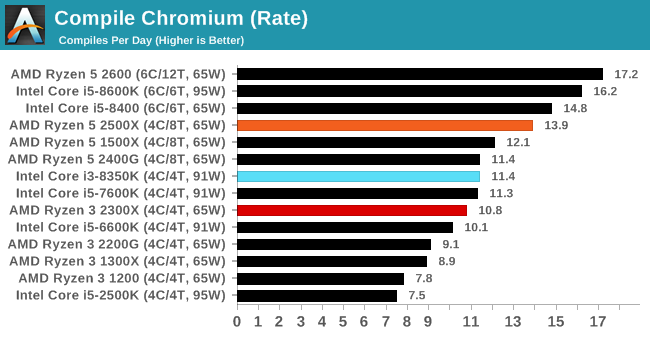
In our compile test, the higher thread count of the 2500X gives it a good lead over the other two comparison points, although the 2300X is only slightly behind the Core i3 here.
3DMark Physics: In-Game Physics Compute
Alongside PCMark is 3DMark, Futuremark’s (UL’s) gaming test suite. Each gaming tests consists of one or two GPU heavy scenes, along with a physics test that is indicative of when the test was written and the platform it is aimed at. The main overriding tests, in order of complexity, are Ice Storm, Cloud Gate, Sky Diver, Fire Strike, and Time Spy.
Some of the subtests offer variants, such as Ice Storm Unlimited, which is aimed at mobile platforms with an off-screen rendering, or Fire Strike Ultra which is aimed at high-end 4K systems with lots of the added features turned on. Time Spy also currently has an AVX-512 mode (which we may be using in the future).
For our tests, we report in Bench the results from every physics test, but for the sake of the review we keep it to the most demanding of each scene: Cloud Gate, Sky Diver, Fire Strike Ultra, and Time Spy.
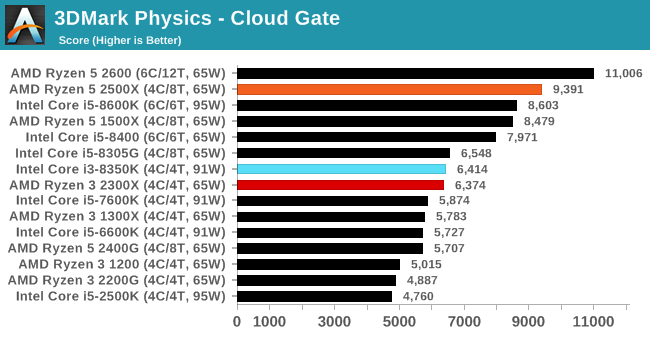
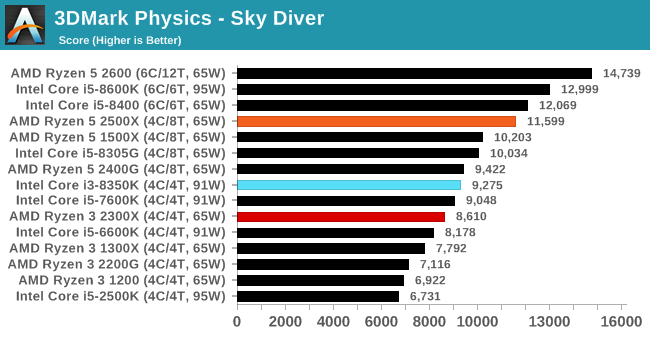
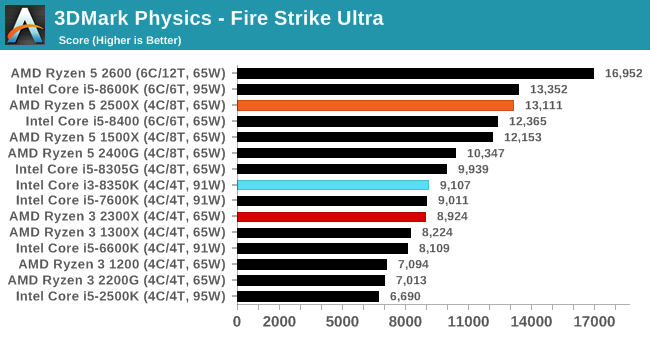
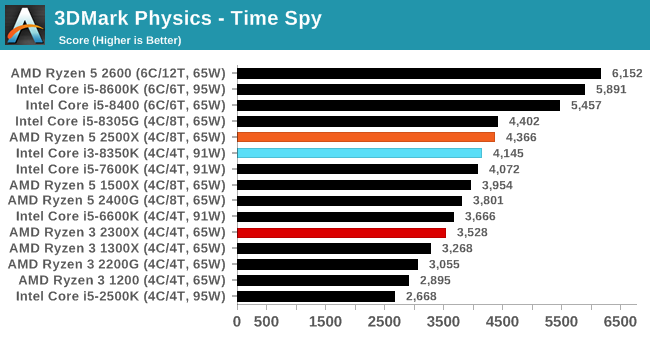
GeekBench4: Synthetics
A common tool for cross-platform testing between mobile, PC, and Mac, GeekBench 4 is an ultimate exercise in synthetic testing across a range of algorithms looking for peak throughput. Tests include encryption, compression, fast Fourier transform, memory operations, n-body physics, matrix operations, histogram manipulation, and HTML parsing.
I’m including this test due to popular demand, although the results do come across as overly synthetic, and a lot of users often put a lot of weight behind the test due to the fact that it is compiled across different platforms (although with different compilers).
We record the main subtest scores (Crypto, Integer, Floating Point, Memory) in our benchmark database, but for the review we post the overall single and multi-threaded results.
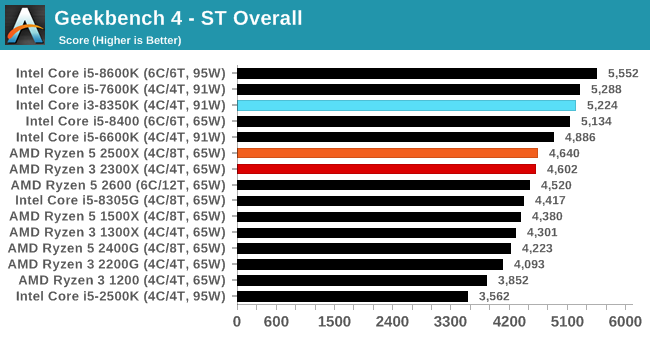
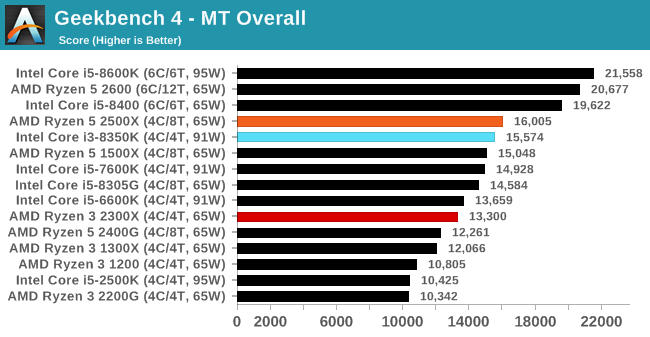










65 Comments
View All Comments
Daeros - Monday, February 11, 2019 - link
Your Intel bias is showing again, Ian. You've pitted a very nice selection of midrange processors from AMD against some very nice, almost double the price chips from Intel. If you're going to include the i5-8400 and i5-8600k, why not the R7 2600x or 2700? They're price-point competitors. But then, Intel wouldn't be at the top of the charts in almost any of the tests, would they?Ian Cutress - Monday, February 11, 2019 - link
All the data is in Bench for those parts. I mention repeatedly (as I did in our buyer's guide) that Intel doesn't really have anything competitive from 8th/9th Gen in the $120-$200 range. I put some parts in that are at least offer thread parity, as explained on page one of this review, if you read that far. But then again, Intel's 8th gen chips are priced well above the usual price right now.Subsequently, your data bias is showing. It's not about being at the absolute top of the graph. It never has. It's about competing with what's around you and some context either side from major competitors. If you want to compare higher priced parts against higher priced parts, then there's either a benchmark database to look at, or the corresponding reviews for those chips.
All quite apart from which, most of my analysis is comparing the AMD parts to other AMD parts because they're not sold at retail and where they would fit in if they did. That's one of the major points of this review.
c4v3man - Monday, February 11, 2019 - link
Is Anandtech trying to acquire an Intel i3-8100 processor for testing? This would seem to be a fairly natural comparison point to these processors at it's $117 customer pricing level. Granted you can approximate the results off the i3-8350K, and assume it's roughly 10% slower, but having actual numbers would be preferred over manual re-calculations.HStewart - Monday, February 11, 2019 - link
What about i5-8400T - according to ARC it price at $179 which will be in price range you statedhttps://www.intel.com/content/www/us/en/products/p...
Big difference is that it does not have Hyperthreading, been 6 cores without hyperthreading it could be serious competitor to Ryzen 5 2500X - it does have lesser max frequency than normal 8400
Korguz - Tuesday, February 12, 2019 - link
HStewart...that price.. could be an intel suggested price, or the tray price....
HStewart - Tuesday, February 12, 2019 - link
It is the price on Amazon, and selling outhttps://www.amazon.com/Intel-CM8068403358913-Core-...
MattMe - Tuesday, February 12, 2019 - link
@Ian - Whilst not quite as militant as some other forum users, I do agree that the testing and comparisons you have used here are not the most appropriate or useful. A similarly priced Intel CPU like the i3 would demonstrate competitive value in the marketplace. If we are including the more expensive Intel CPUs (because of their similar thread count, which I understand) then the graphs should have the equivalently priced AMD alternatives, again to help consumers understand the value proposition from both sides.Regarding the games/GPU options, I feel the testing you have carried out is useful, and although it's unlikely these CPUs would be paired with such a high-end GPU, we are at least ruling out the GPU being the limiting factor until reaching 4k, where your graphs demonstrate that the CPU is no longer the bottleneck. Without doubling the number of tests and data presented in the articles, I feel you've presented the most useful benchmarks and information. You'll never please everyone, I suppose.
Overall I think this is another fantastic write-up and appreciate the effort you put into the research and testing, but I can understand some people's frustrations when it comes to the comparisons you have chosen to demonstrate.
mikato - Thursday, April 4, 2019 - link
Well said"If we are including the more expensive Intel CPUs (because of their similar thread count, which I understand) then the graphs should have the equivalently priced AMD alternatives, again to help consumers understand the value proposition from both sides."
Phynaz - Monday, February 11, 2019 - link
Typical AMD - Hot and SlowformulaLS - Monday, February 11, 2019 - link
Typical Phynaz, quit the forums and said he won't be coming back and ended up flat out lying about it. Grow up dude.